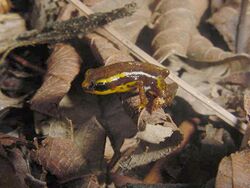Biology:Yellow-striped pygmy eleuth
| Yellow-striped pygmy eleuth | |
|---|---|

| |
| Scientific classification | |
| Domain: | Eukaryota |
| Kingdom: | Animalia |
| Phylum: | Chordata |
| Class: | Amphibia |
| Order: | Anura |
| Family: | Eleutherodactylidae |
| Genus: | Eleutherodactylus |
| Species: | E. limbatus
|
| Binomial name | |
| Eleutherodactylus limbatus (Cope, 1862)
| |
| Synonyms | |
|
Phyllobates limbatus Cope, 1862 | |
The yellow-striped pygmy eleuth (Eleutherodactylus limbatus), also known as the yellow-striped dwarf frog, is a species of frog in the family Eleutherodactylidae from closed mesic and xeric forests in Cuba.[1]
The yellow-striped pygmy eleuth is relatively brightly marked in orange-yellow and among the smallest frogs in the world, up to 1.18 cm (0.46 in) in snout–to–vent length with males marginally smaller than females.[2] It is part of a closely related Cuban group that contains five additional described species (E. cubanus, E. etheridgei, E. iberia, E. jaumei and E. orientalis) and at least one undescribed species; most of which are of tiny size, relatively brightly colored and possibly aposematic (at least E. iberia and E. orientalis have alkaloid toxins in their skin). Among these, the yellow-striped pygmy eleuth is unique in being quite widespread in Cuba, whereas the others all have very small ranges in the eastern part of the island.[3]
Mating calls and reproduction
E. limbatus has a very intense mating call, but it is brief (6.9 to 24.8 milliseconds) and high-pitched (6.5 to 8.3 kHz), at a rate of 278 per minute. Female frogs have a single ovary and lay one egg at a time, which is subsequently buried in the ground, where it develops quickly.[4]
Habitat
These frogs are found in Cuba at elevations up to 1,150 m above sea level, in closed-canopy mesic and xeric forests. Their distribution is highly fragmented,[5] with the total land area equaling 7,700 mi2 (20,000 km2).[1] Within this limited area, though, they are quite numerous.[6]
References
- ↑ 1.0 1.1 1.2 Blair Hedges, Luis Díaz (2010). "Eleutherodactylus limbatus". IUCN Red List of Threatened Species 2010: e.T56719A11523010. doi:10.2305/IUCN.UK.2010-2.RLTS.T56719A11523010.en. https://www.iucnredlist.org/species/56719/11523010. Retrieved 19 November 2021.
- ↑ "Eleutherodactylus limbatus". AmphibiaWeb. Berkeley, California. 12 November 2007. https://amphibiaweb.org/species/3021.
- ↑ Rodríguez, A.; R. Alonso; J.A. Rodríguez; M. Vences (2012). "Geographic distribution, colour variation and molecular diversity of miniature frogs of the Eleutherodactylus limbatus group from Cuba". Salamandra 48 (2): 71–91.
- ↑ "Ranita Pigmea". eleuthare.com. http://www.eleuthare.com/limbatus.html.
- ↑ "Eleutherodactylus limbatus range map". IUCN. http://maps.iucnredlist.org/map.html?id=56719.
- ↑ "Eleutherodactylus limbatus". natureserve. http://www.natureserve.org/infonatura/servlet/InfoNatura?searchName=Eleutherodactylus+limbatus.
Further reading
- http://www.globalamphibians.org/servlet/GAA?searchName=Eleutherodactylus+limbatus
- JSTOR 1447647
- http://www.picsearch.com/info.cgi?q=%22Eleutherodactylus%20limbatus%22&id=muntYNdnS5FzF_IYhhwRWo9K6pdfkD-RKQeGjIB4TXQ
- http://www.itis.gov/servlet/SingleRpt/SingleRpt?search_topic=TSN&search_value=550347
- http://www.eleuthare.com/listae.html
Wikidata ☰ Q2276900 entry
 |



